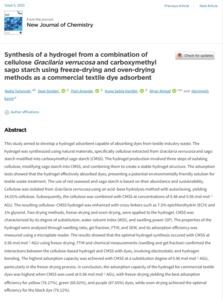Nudia Tuljannah, - and Dewi Sondari, - and Putri Amanda, - and Arzqa Sabila Hanifah, - and Ahyar Ahmad, - and Harningsih Karim, - Synthesis of a hydrogel from a combination of cellulose Gracilaria verrucosa and carboxymethyl sago starch using freeze-drying and oven-drying methods as a commercial textile dye adsorbent. New Journal of Chemistry Issue 5, 2025.
![[thumbnail of abstrak.png]](/45684/1.hassmallThumbnailVersion/abstrak.png)

abstrak.png
Download (186kB) | Preview
Abstract (Abstrak)
This study aimed to develop a hydrogel adsorbent capable of absorbing dyes from textile industry waste. The hydrogel was synthesized using natural materials, specifically cellulose extracted from Gracilaria verrucosa and sago starch modified into carboxymethyl sago starch (CMSS). The hydrogel production involved three steps of isolating cellulose, modifying sago starch into CMSS, and combining them to create a stable hydrogel structure. The adsorption tests showed that the hydrogel effectively absorbed dyes, presenting a potential environmentally friendly solution for textile waste treatment. The use of red seaweed and sago starch is based on their abundance and sustainability. Cellulose was isolated from Gracilaria verrucosa using an acid–base hydrolysis method with autoclaving, yielding 14.01% cellulose. Subsequently, the cellulose was combined with CMSS at concentrations of 0.48 and 0.96 mol mol−1 AGU. The resulting cellulose–CMSS hydrogel was enhanced with cross-linkers such as 7.5% epichlorohydrin (ECH) and 1% glycerol. Two drying methods, freeze-drying and oven-drying, were applied to the hydrogel. CMSS was characterized by its degree of substitution, water solvent index (WSI), and swelling power (SP). The properties of the hydrogel were analyzed through swelling ratio, gel fraction, FTIR, and SEM, and its adsorption efficiency was measured using a microplate reader. The results showed that the optimal hydrogel synthesis occured with CMSS at 0.96 mol mol−1 AGU using freeze-drying. FTIR and chemical measurements (swelling and gel fraction) confirmed the interactions between the cellulose-based hydrogel and CMSS with dyes, involving electrostatic and hydrogen bonding. The highest adsorption capacity was achieved with CMSS at a substitution degree of 0.96 mol mol−1 AGU, particularly in the freeze-drying process. In conclusion, the adsorption capacity of the hydrogel for commercial textile dyes was highest when CMSS was used at 0.96 mol mol−1 AGU, with freeze-drying yielding the best adsorption efficiency for yellow (76.17%), green (69.02%), and purple (87.65%) dyes, while oven-drying achieved the optimal efficiency for the black dye (79.12%).
| Item Type: | Article |
|---|---|
| Subjects: | Q Science > QD Chemistry |
| Divisions (Program Studi): | Fakultas Matematika dan Ilmu Peng. Alam > Kimia |
| Depositing User: | - Andi Anna |
| Date Deposited: | 16 Apr 2025 07:33 |
| Last Modified: | 16 Apr 2025 07:33 |
| URI: | http://repository.unhas.ac.id:443/id/eprint/45684 |


